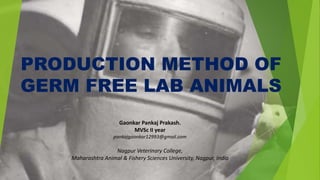
Production Method of Germ Free Lab Animals
- 1. PRODUCTION METHOD OF GERM FREE LAB ANIMALS Gaonkar Pankaj Prakash. MVSc II year pankajgaonkar12993@gmail.com Nagpur Veterinary College, Maharashtra Animal & Fishery Sciences University, Nagpur, India
- 2. DEFINITION Germ Free animal is one which is isolated from all demonstrable living organism like bacteria,virus,fungus,parasite,algae,yeast. The Aim of GF work is ISOLATION (prevent contamination from air,water,food & environment. Synonym- Axenic animal , Gnotobiotic.
- 3. Terminology Gnotobiotic animal:- Animal derived from aseptic caesarean or sterile hatching of eggs i.e. restored and continuously maintained with germ free technique under isolator condition in which flora and fauna is clearly defined.(microbial status is known) Conventional animal:- Animal with uncontrolled flora, reared under open animal room condition is association with other animals of the same type. Axenic Animal :- Free from Strange or raised under sterile condition or germ-free
- 4. HISTORY The concept of a germ-free animal was recognized more than a century ago by Louis Pasteur (1885), although he concluded that bacteria-free existence is impossible. Ten years later in 1895, Nuttle and Thierfelder at Berlin University produced the first GF animals (guinea pigs), which survived for as long as 13 days. However, owing to the lack of knowledge concerning nutrition, it took 50 more years until the first GF rat colonies were established in the late 1940s
- 5. Equipment Sterile isolator and set up for rearing germ free mice Transfer chamber compatible with the isolator Autoclave with validated programs for the sterilizatiion of supplies and drinking water inside the transfer chamber Surgical equipment Luteolil Vet, 50 mg/ml, 0.1 ml, room temperature, CeVa, Holland VirkonS, 1% solution, room temperature, Antec Int. Ltd.
- 6. Isolator Technology Isolators provide physical barriers that allow creation of a sterile environment. These devices have an air supply, air inlet and outlet, transfer port, and arm-length gloves, as well as a special tank filled with disinfectant and used for the transfer of mice in and out (Figs. 1 and 2). Bedding, food, water, and equipment, including cages, must first be sterilized (autoclaved) and are then put into the isolator through the so-called sterile lock. Air is sterilized upon entry and exhaust by mechanical filtration under positive pressure. The transfer of animals in and out of the isolator is usually carried out via autoclave jars (Fig.3). The common practice is to separate multiple mouse strains and multiple inoculation experimental groups in separate isolators [3], altogether increasing the cost and space for such experimentation.
- 8. Fig. 2. Composition of the plastic isolator
- 9. Fig. 2. Composition of the plastic isolator
- 11. Positive Pig tub Isolator
- 12. METHOD Ensure availability of isolator reared, germ-free surrogate mother with newborn pups (<5 days old) at day 19 of procedure (see below). Day 0 Set up the relevant mating of mouse strain to be converted to germ-free status. Day 1 Check for mating plug and identify the donor female(s) for the experiment. Day 17 Give pregnant donor female(s) a subcutaneous injection of Promon (5 mg/0.1 ml). Day 18 Carefully following the protocol for isolator entry procedures, transfer the sterile instruments and supplies required for surgery into the isolator in which the surrogate female(s) are housed. Prepare the hysterectomy suite/surgical transfer chamber: fill up the reservoir with 1% VirkonS, sterilize the surgical compartment and ventilate it overnight. Day 20 Transfer water, paper towels and surgical instruments from the isolator to the sterilized compartment of the transfer chamber.
- 13. Method….continued… Working in the Non-sterile compartment of the surgical transfer chamber; sacrifice the donor female by cervical dislocation and submerge the whole animal in the 1% VirkonS solution for 1 minute. Use sterile scissors to open the abdomen, wear sterile gloves. Clamp the top of each uterine horn and the base of the uterus close to the cervix. Cut out the ‘uterine package’ and place it in the transfer chamber reservoir filled with 1% VirkonS for 1 min.
- 14. Fig. 4. Establishment of GF mice by Caesarean section. (A) The uterine sac is removed and clamped together at the top of each horn and at the base close to the cervix. (B) (B) The uterine sac is placed in a glass jar containing disinfectant. (C) The uterine sac is transferred to the isolator, where it is opened, and the pups are removed, cleaned, and stimulated to breath. (D) The pups are introduced to the GF foster mother.
- 15. Method….continued… Inside the sterile compartment of the transfer chamber; rinse the ‘uterine package’ with sterile water to remove the VirkonS. Open the ‘uterine package’ with scissors and take out the pups. Stimulate breathing of the pups while cleaning them with dry paper towel. When pups are breathing normally and have gained a ‘healthy’ skin color transfer them to the isolator housing the surrogate mother. Take out her own litter and mix pups from both litters outside the cage. Remove some of the original pups so that the surrogate mother has the same number of pups to feed. Gently rub the pups with bedding material from the surrogate mother’s cage soaked in water. Put the mixed litter together with the foster mother. Check for adoption not earlier than 24 hours after transfer. Monitor a microbiological status of the isolator and the animals it houses 3 weeks after transfer.
- 16. USE of GERM FREE Animals To study reactions on the diet and its development on the diet. ACTS AS SOURCE OF STERILE ORGAN,TISSUE. Study defence mechanism Study aetiology of infectious diseases Study process of physiological ageing. Study wound healing process
- 17. REFERENCES EMMA protocol - production of germ-free mice Protocol for generating germ-free (axenic) mice using caesarean section rederivation. Use of Germ-Free Animal Models in Microbiota-Related Research Maha Al-Asmakh1,2* and Fahad Zadjali3 Book:- Care & Management of Laboratory & Pet Animals – Y.B.Rajeshwari
